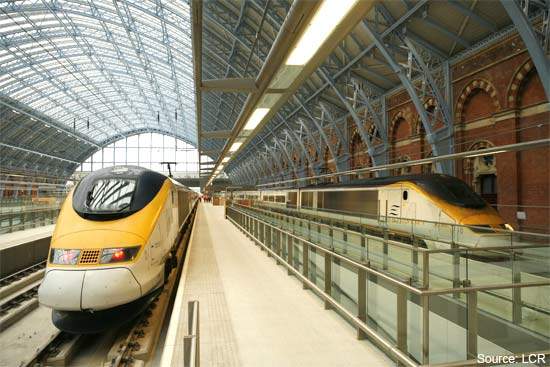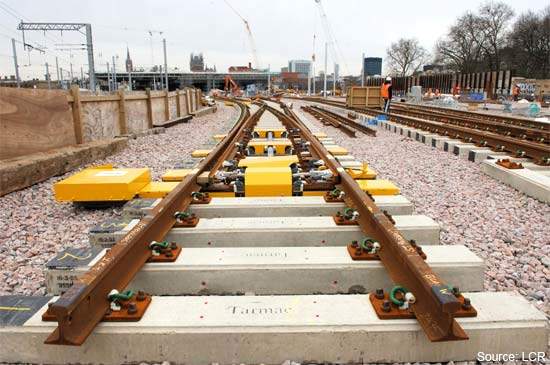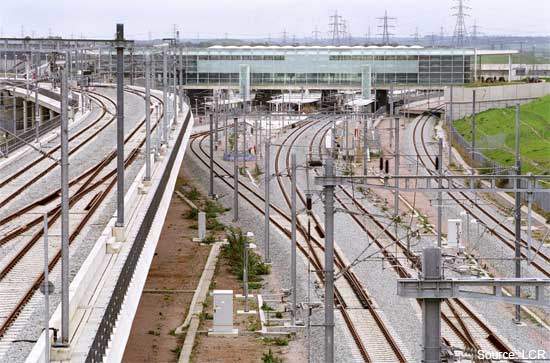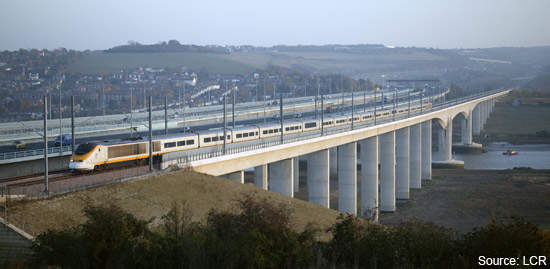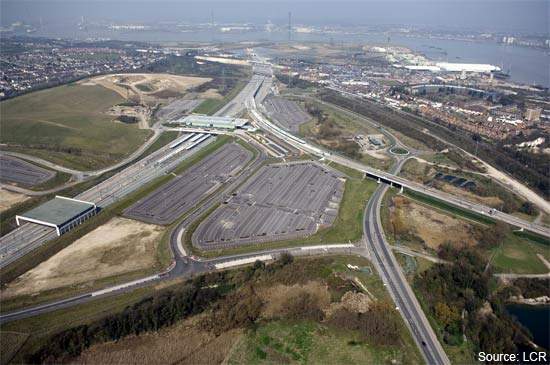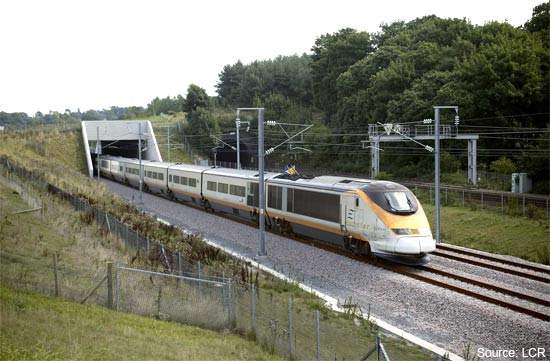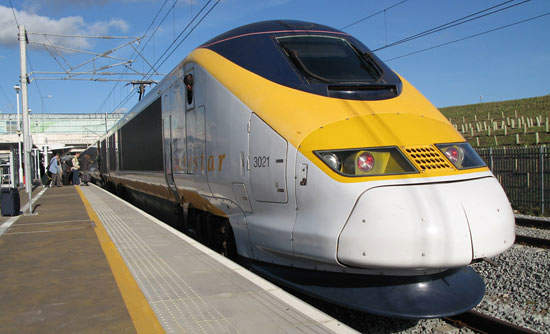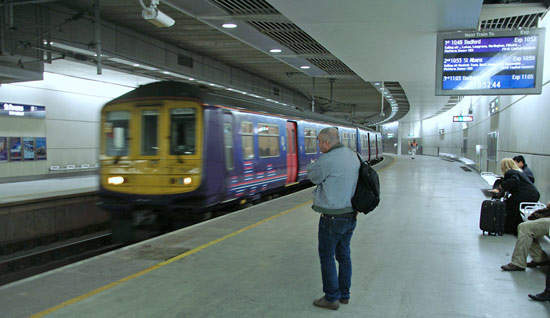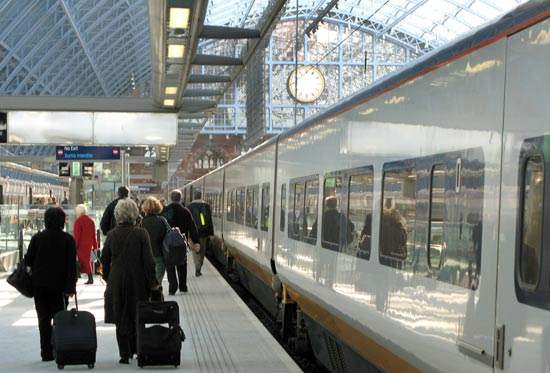The new High Speed 1 (HS1) line is a 108km railway line that slashed journey times from London to Paris, Brussels and Lille when regular services began on 14 November 2007.
The inaugural journey over the line set a new record – on 4 September 2007, a special train carrying journalists and VIPs from Paris Gare du Nord reached London St Pancras in just 2 hours 3 minutes and 39 seconds.
In addition, with the revamped St Pancras International taking over from Waterloo as Eurostar’s London terminus, the option of using the train instead of flying was opened up to many more people outside of London. Even from parts of the north of England, the new service offers broadly similar journey times as air travel when the waits at airports and the subsequent transfers into city centres are taken into account.
With the opening of the final Fawkham Junction to St Pancras section cutting around 20 minutes off the trip, travelling from London to Paris will take 2 hours 15 minutes, with London-Brussels taking 1 hour 51 minutes and London-Lille just 1 hour 20 minutes.
The project cost £5.8bn, of which £800m was spent on the St Pancras redevelopment. This included an extension to double the length of the central platforms to be used for Eurostar and providing additional platforms for existing domestic services, to the west side for East Midlands Trains on the Midland main line and on the east for eventual use by the 140mph (225km/h) ‘Javelin’ service to north Kent.
London and Continental Railways will be the line’s long-term owners, with Network Rail undertaking the management, operation and maintenance.
In a bid to improve travel time and make the journey more enjoyable, a high-speed ‘preview’ service started on 29 June 2009 on HS1, using the Javelin trains from London to Kent. The service was fully introduced in December 2009.
The project
HS1 is the UK’s first high-speed line linking London to the European high-speed rail network – the first new British railway in 100 years. Originally known as the Channel Tunnel Rail Link (CTRL) and first envisaged as a single project, it ran into serious financial difficulties which led to it being split into two separate phases in 1998, in an attempt to safeguard the scheme.
Brought into service in September 2003, the first section runs 45 miles (72km) from the Channel Tunnel at Folkestone to Fawkham Junction in north Kent and includes the ¾ mile (1.2km) long Medway Viaduct and the North Downs Tunnel – 2 miles (3.2km) long and 40ft (12m) in diameter.
The second section covers 24 miles (38km) from Ebbsfleet in Kent to London St Pancras. It runs in a tunnel under the Thames for 1.5 miles (2.5km), then parallel to the London, Tilbury and Southend Railway as far as Dagenham, before entering a 12 mile (20km) long tunnel, broken by a 1km trench section for Stratford International and access track to the new maintenance facility at Temple Mills, and finally emerging a mile from St Pancras.
The completion of HS1 brought the British end of the route up to the same standards as the French and Belgian LGV, enabling trains to run at 186mph (300km/h). With the new line in service, up to eight trains per hour will be able to travel in each direction from London to mainland Europe.
Siting Eurostar’s London terminus at St Pancras International offers better connections within London and more of the UK than had Waterloo, with six Underground lines – Victoria, Northern, Piccadilly, Circle, Hammersmith & City and Metropolitan – serving the station. In addition, St Pancras International has a new sub-surface station on the Thameslink route and is next door to King’s Cross and very close to Euston, the principal stations for Scotland, the north of England and parts of the Midlands.
St Pancras is also to be linked to the site of the 2012 Olympics at Stratford – the project being a factor in London’s successful Olympic Bid, with a seven-minute journey time using the Olympic Javelins for the duration of the Games with a special shuttle service.
However, when Eurostar began operating from St Pancras, Ashford International Station lost its Brussels trains and off-peak Paris services, though it will retain some peak daily trains including domestic services with Javelins operated by Southeastern since December 2009. Reducing peak-time Eurostar services at Ashford to allow them to stop instead at Ebbsfleet attracted much opposition in East Kent.
A completely new station, Ebbsfleet International opened a few days after St Pancras. Close to the north-west Kent town of Dartford and near the M25, M2 and M20 motorways, Ebbsfleet is largely designed around road access, with the expectation of drivers finding convenience in its park and ride facilities, plus having feeder services by bus/coach operators.
With the opening of the new Temple Mills depot to the north of Stratford, the original Eurostar facility at North Pole Junction alongside the Great Western mail line was closed, although it is being considered for reuse as part of the London Crossrail project.
Rolling stock
Constructed by GEC-Alsthom, the ‘Three Capitals’ Class 373 units are essentially modified TGV sets, 400m long, weighing 800t and carrying 750 passengers in 18 carriages. These 20 vehicle trainsets consist of two half-sets of one power car and nine intermediate trailers, with the bogies within each set being articulated and sharing one twin-axled bogie between vehicle ends.
The demands of the different power systems in the UK and mainland Europe means that each train has both pantographs for Europe and third-rail contact shoes (to be dispensed with) for the pre-HS1 routing over the UK’s ‘Southern Region’ and is tri-voltage (750V DC, 25kV 50Hz, 3kV DC). Five SNCF owned sets are quad-voltage (1,500V DC) to allow them to work in southern France.
The trains also need to be able to accommodate three differing overhead catenaries – regular-height on Belgian and French domestic railways, higher through the Channel Tunnel and lower-height on LGV lines. Eurostar trains also have to be able run under four different signalling systems – the domestic systems of each country together with the TVM signalling on the LGV.
There are three braking systems, designed to bring the train from full speed to a standstill in 65 seconds. The motors themselves can operate in a regenerative mode, which provides dynamic braking, while each axle is equipped with four disk brakes. In addition, the power cars have directly operating wheel brakes.
Joint initiative
In April 2009, HS1 and DB Schenker Rail (UK) Ltd have signed a heads of term agreement to cooperate in the development of modifications to Class 92 locomotives to enable them to operate on the high-speed rail line.
HS1 will support the group led by DB Schenker, which has secured Marco Polo funding from the European Commission. HS1 will also lead the software development to the TVM parameters, which will ensure that the modifications required to Class 92 locomotives are available to all owners of Class 92s wishing to operate over the HS1 infrastructure.
The partners have also agreed the terms for a track access agreement in anticipation of the start of freight services on HS1 infrastructure by early 2010.
Prospects for the construction of a domestic high-speed rail line are also inching closer, with Network Rail reportedly launching a strategic review into the case for building new lines. Costing £20bn, of which £4.4bn would come from the private sector, the first line would link Heathrow with London St Pancras, Birmingham, Manchester and Leeds. Work would begin in 2015 for full completion by 2027.
High Speed 2 (HS2) has been established by the UK government to consider the case for new high-speed services between London and Scotland. The HS2 report was submitted to the UK Government in December 2009.
The future
A High Speed 2 line between London and Birmingham has been planned by the UK Government. The planned line will serve the Midlands and North West regions.
Principally forwarded by the Greengauge 21 pressure group, with HS1 having become part of the railway product, infrastructure organisation Network Rail had by early 2008 also begun to make public comments about further high-speed lines. With continuing increases in demand on the traditional routes, high-speed lines are held out not only as a way of shortening journey times between major population centres, but also being the most effective way of increasing capacity on the rail network overall, mirroring the situation on SNCF’s busiest LGV in France.
As proven by Eurostar sets having been used by GNER on the UK East Coast route, the sets could use high-speed alignments for long distances and the traditional infrastructure to serve city centres, as is the norm in France. The next high-speed line would almost certainly serve the main centres as per the current West Coast Main Line, followed by the East Coast counterpart and the Great Western route to Bristol and South Wales.


